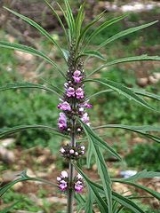
Leonurus sibiricus
Encyclopedia
Leonurus sibiricus, commonly called Honeyweed or Siberian motherwort, is an herbaceous plant species native to central
and Southwest Asia
, including China, Mongolia, and Russia. It is naturalized in many other parts of the world, including South, Central and North Americas.
or biennial
with upright stems that grow from 20 to 80 cm tall. Plants have long petioled basal leaves that are ovate-cordate in shape. The leaves have toothed margins and are incised with deeply cut lobes. Typically one or a few flowering stems are produced from short tap-roots. The lower stem leaves are deciduous
and wither away as the plants begin blooming. The petioles
of the leaves, midway up the stems are 2 cm long. The flowers are produced in many flowered verticillasters, produced in whorls
around the top half or more of the stem. The flowers are sessile
with 8 mm long calyxs that are tubular-campanulate in shape. The corolla is white or reddish to purple-red, with an upper lip that is oblong in shape and longer than the lower lip. When flowering is done, brown oblong shaped nutlet
s are produced in good number. Blooming occurs from July into late September, but flowering can occur year round when climate permits.
This species' habitat within its natural range is stony or sandy grasslands or pine forests.
 Alkaloids isolated from the plant include:
Alkaloids isolated from the plant include:
Central Asia
Central Asia is a core region of the Asian continent from the Caspian Sea in the west, China in the east, Afghanistan in the south, and Russia in the north...
and Southwest Asia
Southwest Asia
Western Asia, West Asia, Southwest Asia or Southwestern Asia are terms that describe the westernmost portion of Asia. The terms are partly coterminous with the Middle East, which describes a geographical position in relation to Western Europe rather than its location within Asia...
, including China, Mongolia, and Russia. It is naturalized in many other parts of the world, including South, Central and North Americas.
Description
Leonurus sibiricusis an herbaceous annualAnnual plant
An annual plant is a plant that usually germinates, flowers, and dies in a year or season. True annuals will only live longer than a year if they are prevented from setting seed...
or biennial
Biennial plant
A biennial plant is a flowering plant that takes two years to complete its biological lifecycle. In the first year the plant grows leaves, stems, and roots , then it enters a period of dormancy over the colder months. Usually the stem remains very short and the leaves are low to the ground, forming...
with upright stems that grow from 20 to 80 cm tall. Plants have long petioled basal leaves that are ovate-cordate in shape. The leaves have toothed margins and are incised with deeply cut lobes. Typically one or a few flowering stems are produced from short tap-roots. The lower stem leaves are deciduous
Deciduous
Deciduous means "falling off at maturity" or "tending to fall off", and is typically used in reference to trees or shrubs that lose their leaves seasonally, and to the shedding of other plant structures such as petals after flowering or fruit when ripe...
and wither away as the plants begin blooming. The petioles
Petiole (botany)
In botany, the petiole is the stalk attaching the leaf blade to the stem. The petiole usually has the same internal structure as the stem. Outgrowths appearing on each side of the petiole are called stipules. Leaves lacking a petiole are called sessile, or clasping when they partly surround the...
of the leaves, midway up the stems are 2 cm long. The flowers are produced in many flowered verticillasters, produced in whorls
Whorl (botany)
In botany, a whorl is an arrangement of sepals, petals, leaves, or branches in which all the parts are attached at the same point and surround or wrap around the stem.There are four whorls in a general flower...
around the top half or more of the stem. The flowers are sessile
Sessility (botany)
In botany, sessility is a characteristic of plants whose flowers or leaves are borne directly from the stem or peduncle, and thus lack a petiole or pedicel...
with 8 mm long calyxs that are tubular-campanulate in shape. The corolla is white or reddish to purple-red, with an upper lip that is oblong in shape and longer than the lower lip. When flowering is done, brown oblong shaped nutlet
Nutlet
Nutlet may refer to one of the following.*A small nut.*In botany, a nutlet is a pyrena or pyrene, which is a seed covered by a stony layer, such as the kernel of a drupe....
s are produced in good number. Blooming occurs from July into late September, but flowering can occur year round when climate permits.
This species' habitat within its natural range is stony or sandy grasslands or pine forests.
Alkaloids

- Cycloleonurinine
- Leoheterin
- LeonurineLeonurineLeonurine is one of the chemical constituents of the South African plant Leonotis leonurus. It is a psychoactive alkaloid found in species Leonotis nepetifolia, Leonotis artemisia as well as other plants of family Lamiaceae...
- Leonurinine
- Leuronurine
- Prehispanolone
- Preleoheterin
- Stachydrine

